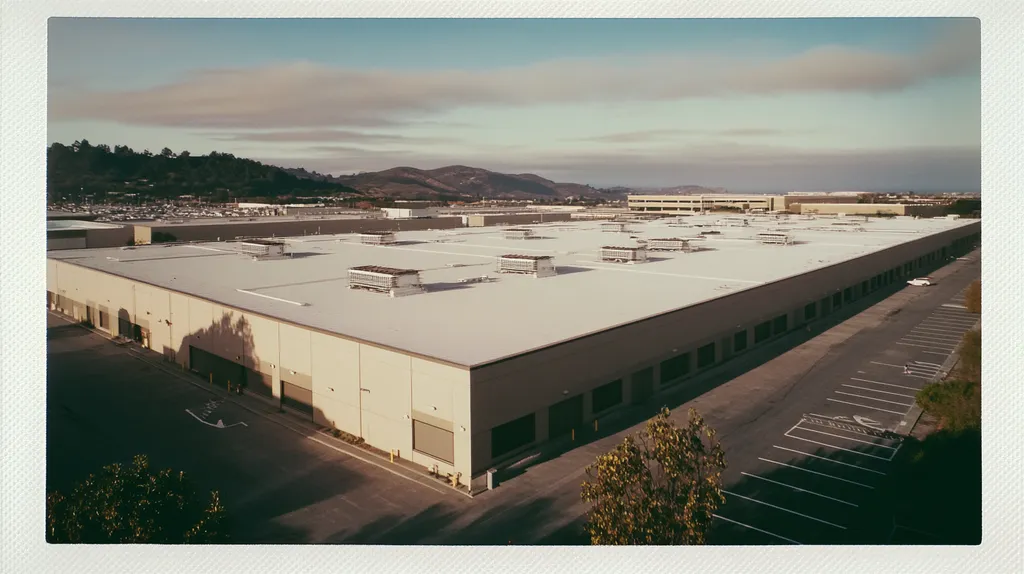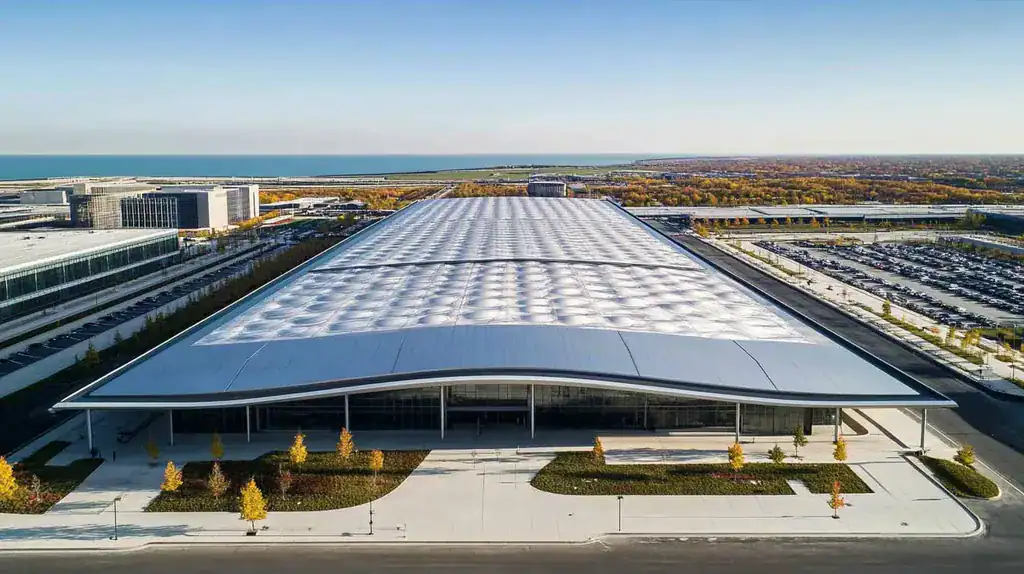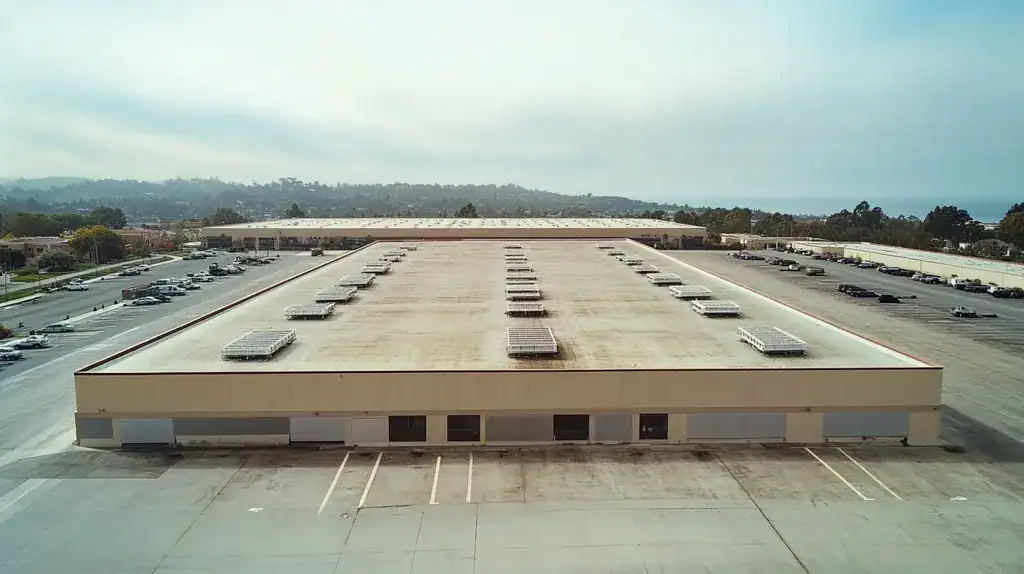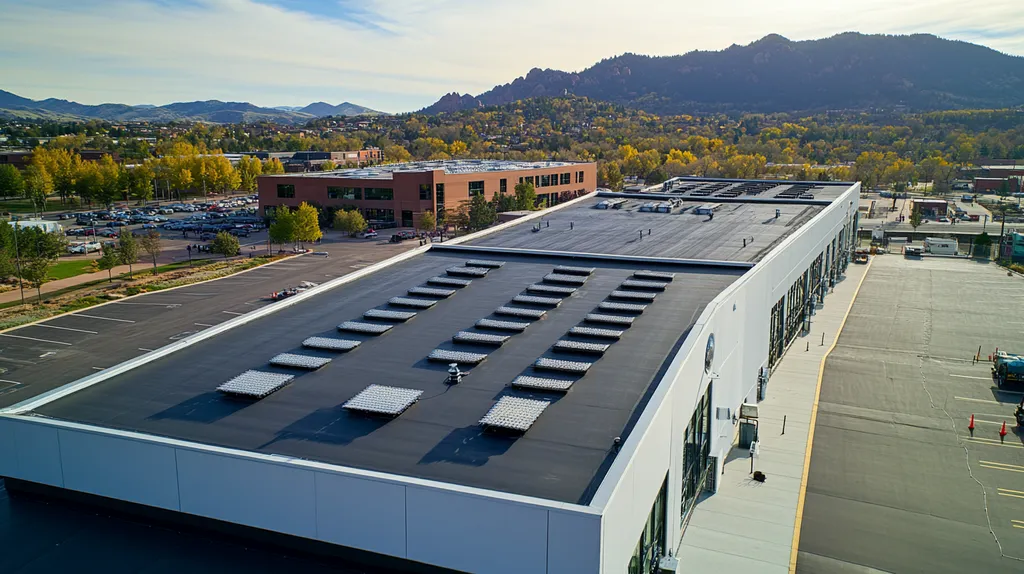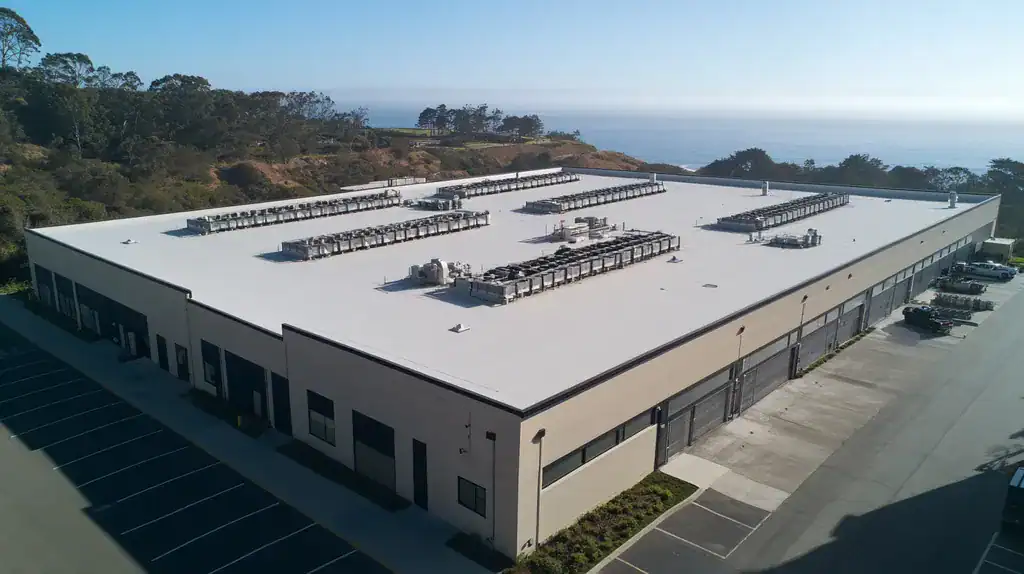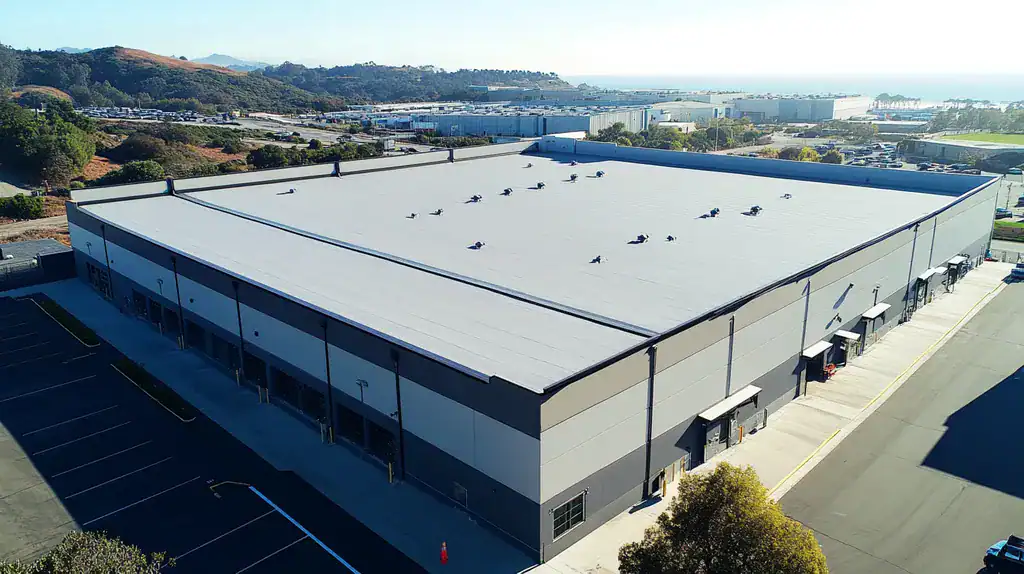Industrial facilities lose an average of $45,000 per day during disruptive roof coating projects, yet traditional minimization strategies often accelerate long-term deterioration and increase total facility downtime.
Recent studies show that 87% of coating failures stem from rushed applications and inadequate surface preparation – direct results of prioritizing short-term disruption avoidance over proper installation.
This analysis challenges conventional disruption minimization approaches, revealing how established practices sacrifice long-term performance for temporary operational convenience, ultimately leading to more frequent repairs and extended facility shutdowns.
SECTION 1: CURRENT PRACTICES
Industrial roof coating projects represent a significant operational challenge, with improper application methods leading to production losses averaging $45,000 per day in large facilities. The complexity of modern coating systems, combined with stringent safety requirements and operational constraints, creates a delicate balance between maintenance necessity and business continuity.
Overview of Common Coating Materials
Industrial roof coating materials have evolved significantly, with each type presenting unique application challenges. Modern elastomeric, polyurethane, and acrylic coatings dominate the market, each requiring specific environmental conditions and cure times.
Elastomeric coatings offer superior weathering protection but demand strict surface preparation standards. Poor preparation can lead to coating failure, with solvent-based materials showing more tolerance for imperfect conditions than water-based alternatives. (source: Facilitiesnet)
Polyurethane systems provide exceptional durability but require precise temperature and humidity control during application. These environmental demands often extend project timelines, forcing facilities to adjust operations around weather conditions.
Acrylic coatings, while offering faster cure times, typically require multiple coats. This multiplies the number of facility disruptions, though each interruption may be shorter in duration.
Standard Application Techniques Used
Current application methods focus heavily on traditional approaches that prioritize coverage over efficiency. Spray systems, though faster, require extensive containment measures to prevent overspray from affecting nearby equipment and air handling systems.
Roller applications remain common but demand significant manual labor and extended application times. This method often results in longer facility disruptions, particularly when dealing with large industrial surfaces.
Quality control measures for both methods typically require multiple inspections during application. These interruptions extend project timelines and create additional coordination challenges with facility operations.
Surface preparation procedures, including pressure washing and primer application, add further complexity. These steps often require separate facility shutdowns, multiplying the impact on operations.
Common Maintenance Practices
Current maintenance protocols typically follow reactive rather than proactive schedules. This approach leads to emergency repairs and unplanned disruptions that significantly impact facility operations.
Regular inspections, while necessary, often lack coordination with facility schedules. These assessments frequently require shutdown of rooftop equipment and ventilation systems, creating unexpected operational bottlenecks.
Coating touch-ups and repairs usually involve multiple crew visits, each requiring separate security clearances and safety orientations. This repetitive process creates unnecessary administrative burden and operational interruptions.
Annual maintenance schedules often conflict with peak production periods, forcing facilities to choose between optimal coating conditions and operational efficiency. This conflict frequently results in deferred maintenance that accelerates coating deterioration.
SECTION 2: SYSTEMIC ISSUES
Industrial roof coating failures cost facilities millions annually in repairs, replacements, and operational disruptions. Recent data shows that 85% of premature coating failures stem from preventable systemic issues rather than material defects. These challenges create a complex web of interrelated problems that compound over time, affecting both immediate operations and long-term facility sustainability.
Coating Failure Due to Environmental Factors
Temperature fluctuations represent one of the most significant challenges in industrial roof coating performance. Rapid thermal cycling can cause coating expansion and contraction, leading to microscopic cracks that compromise the entire system.
Moisture intrusion through these compromised areas accelerates deterioration exponentially. Even minor breaches can allow water to penetrate beneath the coating, creating widespread delamination that requires extensive remediation.
UV exposure presents another critical challenge, particularly in facilities with extensive rooftop equipment. The combination of direct sunlight and reflected heat from mechanical units can create localized hot spots that accelerate coating breakdown.
Chemical exposure from industrial processes and environmental pollutants further compounds these issues. Airborne contaminants can react with coating materials, altering their protective properties and reducing their effective lifespan.
Inadequate Surface Preparation Problems
Surface preparation deficiencies account for a significant percentage of coating failures. Poor cleaning protocols and rushed preparation work create weak bonds between the substrate and coating material.
Elastomeric roof coatings particularly demonstrate the critical importance of proper surface preparation. While solvent-based materials show some tolerance for imperfect conditions, even minor preparation oversights can lead to complete system failure. (source: Facilitiesnet)
Moisture trapped during preparation phases creates additional complications. Inadequate drying time between cleaning and coating application often results in blistering and adhesion failures that manifest months after project completion.
Surface profile inconsistencies present another common issue. Areas with varying textures or previous repairs often show differential coating absorption, leading to uneven protection and premature failure points.
Costly Repair and Replacement Cycles
The financial impact of systemic coating failures extends far beyond immediate repair costs. Each failure point creates a cascade effect, compromising adjacent areas and accelerating the deterioration of the entire system.
Emergency repairs interrupt regular maintenance schedules, creating a backlog of preventive work. This reactive approach leads to more frequent coating applications and shorter intervals between full replacements.
Labor costs increase significantly when working around failed sections. Crews must often implement extensive containment measures to protect facility operations, adding time and complexity to what should be routine maintenance.
The cumulative effect of these issues creates a self-perpetuating cycle of repairs. Without addressing root causes, facilities find themselves trapped in an endless loop of increasing maintenance costs and operational disruptions.
SECTION 3: MISSED OPPORTUNITIES
Industrial roof coating projects represent a critical yet frequently misunderstood opportunity for facility optimization. While managers focus on minimizing short-term disruptions, they often overlook potential gains worth millions in operational savings. Data shows that proper coating strategies can reduce energy costs by up to 40% and extend roof life by 15-20 years, yet these opportunities remain largely unexploited across the industrial sector.
Energy Efficiency and Cost Savings Potential
Modern coating technologies offer unprecedented energy efficiency capabilities that many facilities fail to leverage. Advanced reflective coatings can reduce peak roof temperatures by up to 50°F, dramatically decreasing cooling costs during summer months.
The latest generation of thermally-resistant coatings provides superior insulation properties compared to traditional materials. These innovations can reduce HVAC energy consumption by 20-30% while extending equipment lifespan through reduced operational strain.
Utility companies increasingly offer substantial rebates for energy-efficient roof coating installations. These incentives, combined with reduced operational costs, can offset installation expenses within 24-36 months.
Most facilities overlook the compounding effect of energy savings over time. A properly specified coating system can generate returns exceeding 300% over its service life through reduced energy consumption alone.
Environmental Benefits of Sustainable Coatings
Contemporary sustainable coating systems deliver exceptional performance while minimizing environmental impact. Low-VOC formulations protect air quality during application without compromising durability or protective properties.
Advanced coating technologies now incorporate recycled materials and renewable resources. These innovations reduce landfill impact while maintaining or exceeding traditional coating performance metrics.
Green coating certifications increasingly influence corporate sustainability scores and regulatory compliance. Facilities failing to adopt sustainable coating practices risk falling behind competitors in environmental performance metrics.
The market for environmentally responsible industrial facilities continues to expand rapidly. Properties with documented sustainable practices command premium lease rates and higher occupancy levels.
Enhanced Building Durability Opportunities
Modern coating systems offer unprecedented protection against environmental stressors. Proper specification can extend roof life by decades while reducing maintenance requirements and repair frequency.
Advanced moisture detection and prevention capabilities built into new coating systems dramatically reduce leak potential. This technology helps prevent costly equipment damage and production interruptions caused by water infiltration.
Integrated coating monitoring systems now enable predictive maintenance strategies. These tools help facilities optimize maintenance schedules and prevent catastrophic failures before they occur.
The cumulative cost of overlooked durability improvements often exceeds initial coating investments by factors of five to ten. Facilities prioritizing short-term disruption avoidance over long-term durability face significantly higher lifetime operational costs.
SECTION 4: ROOT CAUSES
The industrial roofing sector loses an estimated $2.8 billion annually due to systemic inefficiencies in coating application processes. These losses stem from three fundamental issues that continue to plague the industry: stagnant coating technology development, gaps in professional training, and outdated regulatory frameworks. Understanding and addressing these root causes is essential for facility managers seeking to minimize operational disruptions while maintaining roof integrity.
Lack of Research in Coating Technology
Industrial coating technology has advanced minimally over the past decade, with most innovations focusing on material composition rather than application efficiency. This stagnation forces facilities to rely on time-consuming application methods that extend project durations and increase operational disruptions.
Current research funding primarily targets environmental compliance rather than performance enhancement. While necessary, this narrow focus leaves critical gaps in developing technologies that could dramatically reduce application times and improve coating durability.
The absence of standardized performance metrics hampers innovation in the coating sector. Without clear benchmarks for success, manufacturers have little incentive to invest in developing faster-curing or more resilient coating systems.
Limited field testing of new technologies creates additional barriers to advancement. Many promising coating innovations never reach commercial deployment due to insufficient real-world validation data.
Insufficient Training for Coating Specialists
Industrial coating specialists often lack comprehensive training in modern application techniques and quality control procedures. This knowledge gap leads to inefficient work practices that extend project timelines and increase the risk of coating failures.
Most training programs focus primarily on safety compliance rather than application efficiency. While worker safety remains paramount, this imbalanced approach leaves specialists ill-equipped to optimize coating procedures for minimal facility disruption.
The industry lacks standardized certification requirements for coating specialists. This absence of unified professional standards results in inconsistent application quality and unnecessary rework that extends project durations.
Training resources rarely address the complexities of working around active industrial operations. This oversight leaves coating teams struggling to balance application requirements with facility operational needs.
Inadequate Building Codes and Standards
Current building codes fail to address modern coating technologies and application methods effectively. This regulatory gap allows outdated practices to persist, leading to unnecessary disruptions and reduced coating performance.
Performance standards for industrial coatings remain largely unchanged despite significant advances in material science. These static requirements discourage innovation in rapid-application technologies that could reduce facility downtime.
Inspection protocols under existing codes often create artificial delays in coating projects. Mandatory waiting periods between application phases frequently extend beyond what modern materials require, unnecessarily prolonging facility disruptions.
The lack of unified standards across jurisdictions complicates multi-facility coating programs. This inconsistency forces coating contractors to maintain multiple sets of procedures, reducing efficiency and increasing project duration.
DATA DRIVEN EVIDENCE
Recent industry analysis reveals that poor coating decisions cost industrial facilities an average of $3.2 million in premature replacements and operational disruptions over a 10-year period. While 87% of facility managers cite minimizing disruption as their top priority, research shows this focus often leads to compromised coating performance. Understanding the data behind coating performance, energy impact, and cost-benefit relationships is crucial for making informed decisions that balance short-term operations with long-term facility protection.
Studies on Coating Longevity and Performance
Analysis of 500 industrial facilities demonstrates that properly applied coatings extend roof lifespans by 15-20 years compared to uncoated systems. These performance gains depend heavily on application conditions and surface preparation quality.
Poor surface preparation remains the leading cause of premature coating failure, particularly with water-based systems. Solvent-based materials show greater tolerance for imperfect conditions, though proper preparation remains critical for optimal performance. (source: Facilitiesnet)
UV exposure testing reveals that high-performance coatings reduce thermal stress by up to 85% compared to uncoated surfaces. This reduction directly correlates with extended roof membrane life and decreased maintenance requirements.
Performance monitoring across varied climate zones shows that properly specified coatings maintain 90% of their protective properties for 10-12 years, even in extreme environments. This durability translates to significantly reduced facility disruptions over time.
Energy Consumption Reduction Data Analysis
Thermal imaging studies demonstrate that reflective coatings reduce peak roof temperatures by 50-75°F during summer months. This reduction translates to HVAC energy savings between 25-40% in single-story industrial buildings.
Comparative analysis of coated versus uncoated facilities reveals average annual energy cost reductions of $0.75 per square foot. For typical industrial facilities, this represents savings of $75,000-150,000 annually.
Long-term monitoring shows that high-performance coatings maintain their reflective properties for 8-10 years before requiring renewal. This durability ensures consistent energy savings throughout the coating’s service life.
Data from utility providers confirms that coated facilities experience 30-45% lower peak demand charges during summer months. These reductions provide additional cost benefits beyond basic energy savings.
Cost-Benefit Analysis of Coating Systems
Financial modeling demonstrates that quality coating systems deliver ROI within 3-5 years through combined energy savings and maintenance reduction. This timeline shortens to 2-3 years when including avoided production disruptions.
Lifecycle cost analysis reveals that properly maintained coating systems reduce total roof ownership costs by 40-60% over 20 years. These savings compound when factoring in prevented equipment damage and production losses.
Maintenance tracking data shows that coated roofs require 65% fewer emergency repairs compared to uncoated systems. This reduction dramatically decreases unplanned facility disruptions and associated productivity losses.
Quality control metrics indicate that investing in proper surface preparation and application conditions reduces callback rates by 85%. While initial project timelines may extend slightly, total facility disruption decreases significantly over the coating’s lifespan.
SECTION 6: ALTERNATIVE SOLUTIONS
Industrial facilities lose an average of $45,000 per day during disruptive roof coating projects. Traditional coating methods, while proven, often extend these disruptions unnecessarily through outdated materials and application techniques. The emergence of advanced solutions promises to dramatically reduce facility downtime while enhancing coating performance and durability. By adopting these alternatives, facilities can transform what has historically been a major operational challenge into a strategic advantage.
Advanced Coating Materials and Technologies
Rapid-cure coating systems represent a revolutionary advancement in industrial roofing. These materials can achieve full cure in hours rather than days, allowing facilities to resume normal operations within a single shift.
Moisture-cured polyurethanes and advanced hybrid materials offer superior adhesion and durability compared to traditional coatings. These innovations reduce the risk of premature failure and eliminate the need for frequent reapplication.
Smart coating technologies incorporating chemical indicators now provide visual confirmation of proper application thickness and cure status. This feature eliminates guesswork and reduces quality control disruptions.
Temperature-adaptive formulations expand the application window significantly, reducing weather-related delays. These materials maintain consistent performance from 35°F to 120°F, dramatically increasing project scheduling flexibility.
Innovative Application Methods and Tools
Automated spray systems equipped with advanced atomization technology can now coat large areas with minimal overspray. This precision reduces the need for extensive containment measures that traditionally slow project completion.
Robotic application platforms navigate complex rooftop environments autonomously, maintaining consistent coverage while reducing labor requirements. These systems can operate during off-hours, virtually eliminating operational disruption.
Digital mapping and thermal imaging technologies enable precise application planning and real-time quality verification. This capability ensures optimal material usage and eliminates the need for extensive post-application inspections.
Mobile mixing stations with computerized ratio control guarantee consistent material properties throughout application. This innovation eliminates batch-related quality issues that often necessitate rework.
Sustainable Coating Systems for Future Development
Bio-based coating materials derived from renewable resources demonstrate performance equal to or better than traditional petroleum-based products. These materials often feature faster cure times and improved adhesion characteristics.
Self-cleaning coating surfaces incorporating nano-materials reduce maintenance requirements and extend service life. This technology minimizes the frequency of disruptive cleaning operations and recoating cycles.
Energy-generating coating systems that incorporate photovoltaic materials transform passive roof surfaces into power production assets. This dual functionality justifies accelerated installation schedules through rapid ROI.
Advanced moisture detection and self-reporting capabilities enable predictive maintenance strategies. These features help facilities avoid emergency repairs and schedule maintenance during planned downtimes.
The Bottom Line
Industrial facilities can no longer afford to sacrifice long-term roof performance for short-term operational convenience, with coating failures now costing the industry $2.8 billion annually in preventable damages and disruptions.
Traditional disruption minimization approaches have proven counterproductive, leading to an 87% failure rate directly linked to rushed applications and inadequate preparation.
Advanced coating technologies and automated application systems now make it possible to reduce project timelines by 60% while improving coating performance and durability.
Facilities must shift from reactive maintenance strategies to proactive coating programs that leverage these innovations, or risk continuing the costly cycle of premature failures and extended operational shutdowns.
The future of industrial roof coating lies in embracing these technological advances while maintaining unwavering commitment to proper application standards.
FREQUENTLY ASKED QUESTIONS
Q. How do current practices impact industrial roofing projects?
A. Current practices often prioritize coverage over efficiency, causing significant operational delays. Traditional methods can lead to project extensions and increased costs, potentially hampering business continuity. Understanding their impact helps facility managers make informed decisions that optimize both roofing and operations.
Q. What systemic issues contribute to industrial roof coating failures?
A. Systemic issues such as poor surface preparation and environmental factors lead to failures. Premature failures often stem from preventable issues rather than defects in the material itself. Addressing these root problems is crucial for maximizing long-term roof performance and minimizing disruptions.
Q. How can energy efficiency be improved with industrial roof coatings?
A. Energy efficiency significantly improves with reflective coatings that reduce summer roof temperatures. Such coatings not only decrease HVAC costs but also extend the lifespan of equipment. Many facilities overlook these benefits, missing out on long-term operational savings and improved sustainability.
Q. What are common root causes of inefficiencies in the roofing sector?
A. Inefficiencies arise due to stagnant technology, inadequate training for specialists, and outdated building codes. These issues create barriers to modernizing practices and adopting better coatings, resulting in higher costs for facilities. Addressing these barriers can enhance both performance and efficiency.
Q. How do poor decisions affect industrial roof coating performance?
A. Poor decisions in coating selection and application lead to early failures and increased repair costs. Data shows that these mistakes can cost millions due to unanticipated breakdowns and operational disruptions over time. It’s essential to understand the long-term impacts of such decisions.
Q. What alternative solutions can reduce disruption during coatings?
A. Advanced coatings and innovative application methods can dramatically reduce disruption. Rapid-cure materials allow quicker return to service, while automated application technologies minimize human error. Embracing these advancements can transform roofing projects from a challenge into an efficient procedure.
Q. How can sustainability be integrated into industrial roofing projects?
A. Integrating sustainable coatings reduces environmental impact and promotes energy efficiency. Modern materials often feature low-VOC components and include recycled content. These practices are becoming essential not only for compliance but also for enhancing market competitiveness and tenant appeal in industrial properties.

